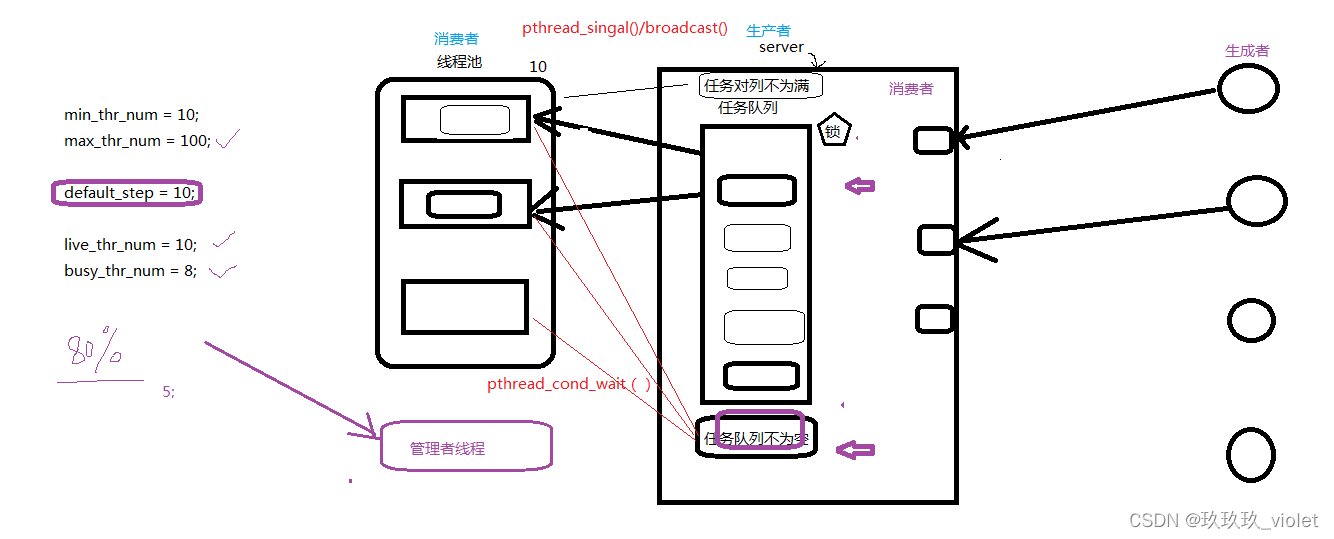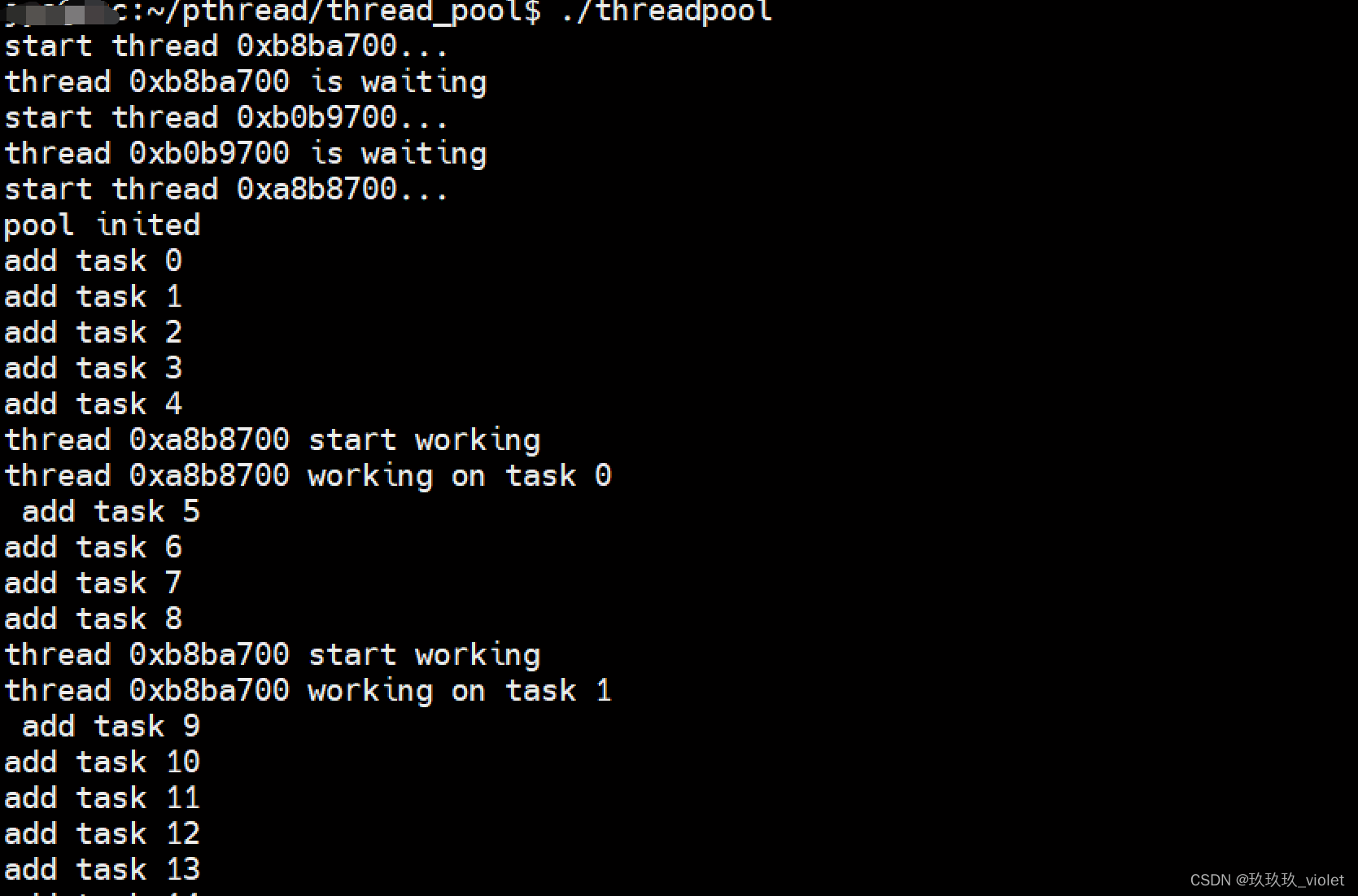线程池理解
线程池
线程池是一种利用池化技术思想来实现的线程管理技术,主要是为了复用线程、便利地管理线程和任务、并将线程的创建和任务的执行解耦开来。我们可以创建线程池来复用已经创建的线程来降低频繁创建和销毁线程所带来的资源消耗。
线程池的优点:
降低资源消耗,复用已创建的线程来降低创建和销毁线程的消耗。
提高响应速度,任务到达时,可以不需要等待线程的创建立即执行。
提高线程的可管理性,使用线程池能够统一的分配、调优和监控。
线程池常见的应用场景如下:
需要大量的线程来完成任务,且完成任务的时间比较短。
对性能要求苛刻的应用,比如要求服务器迅速响应客户请求。
接受突发性的大量请求,但不至于使服务器因此产生大量线程的应用。
像Web服务器完成网页请求这样的任务,使用线程池技术是非常合适的。因为单个任务小,而任务数量巨大,你可以想象一个热门网站的点击次数。
对于长时间的任务,比如Telnet连接请求,线程池的优点就不明显了。因为Telnet会话时间比线程的创建时间大多了。
突发性大量客户请求,在没有线程池的情况下,将产生大量线程,虽然理论上大部分操作系统线程数目最大值不是问题,但短时间内产生大量线程可能使内存到达极限,出现错误。
为什么线程池中需要有互斥锁和条件变量?
线程池中的任务队列是会被多个执行流同时访问的临界资源,因此我们需要引入互斥锁对任务队列进行保护
线程池当中的线程要从任务队列里拿任务,前提条件是任务队列中必须要有任务,因此线程池当中的线程在拿任务之前,需要先判断任务队列当中是否有任务,若此时任务队列为空,那么该线程应该进行等待,直到任务队列中有任务时再将其唤醒,因此我们需要引入条件变量。
当外部线程向任务队列中Push一个任务后,此时可能有线程正处于等待状态,因此在新增任务后需要唤醒在条件变量下等待的线程。
注意:
当某线程被唤醒时,其可能是被异常或是伪唤醒,或者是一些广播类的唤醒线程操作而导致所有线程被唤醒,使得在被唤醒的若干线程中,只有个别线程能拿到任务。此时应该让被唤醒的线程再次判断是否满足被唤醒条件,所以在判断任务队列是否为空时,应该使用while进行判断,而不是if。
pthread_cond_broadcast函数的作用是唤醒条件变量下的所有线程,而外部可能只Push了一个任务,我们却把全部在等待的线程都唤醒了,此时这些线程就都会去任务队列获取任务,但最终只有一个线程能得到任务。一瞬间唤醒大量的线程可能会导致系统震荡,这叫做惊群效应。因此在唤醒线程时最好使用pthread_cond_signal函数唤醒正在等待的一个线程即可。
当线程从任务队列中拿到任务后,该任务就已经属于当前线程了,与其他线程已经没有关系了,因此应该在解锁之后再进行处理任务,而不是在解锁之前进行。因为处理任务的过程可能会耗费一定的时间,所以我们不要将其放到临界区当中。
代码实现

#include <stdlib.h>
#include <pthread.h>
#include <unistd.h>
#include <assert.h>
#include <stdio.h>
#include <string.h>
#include <signal.h>
#include <errno.h>
#include "threadpool.h"
#define DEFAULT_TIME 4 /*10s检测一次*/
#define MIN_WAIT_TASK_NUM 10 /*如果queue_size > MIN_WAIT_TASK_NUM 添加新的线程到线程池*/
#define DEFAULT_THREAD_VARY 10 /*每次创建和销毁线程的个数*/
#define true 1
#define false 0
typedef struct {
void *(*function)(void *); /* 函数指针,回调函数 */
void *arg; /* 上面函数的参数 */
} threadpool_task_t; /* 各子线程任务结构体 */
/* 描述线程池相关信息 */
struct threadpool_t {
pthread_mutex_t lock; /* 用于锁住本结构体 */
pthread_mutex_t thread_counter; /* 记录忙状态线程个数de琐 -- busy_thr_num */
pthread_cond_t queue_not_full; /* 当任务队列满时,添加任务的线程阻塞,等待此条件变量 */
pthread_cond_t queue_not_empty; /* 任务队列里不为空时,通知等待任务的线程 */
pthread_t *threads; /* 存放线程池中每个线程的tid。数组 */
pthread_t adjust_tid; /* 存管理线程tid */
threadpool_task_t *task_queue; /* 任务队列 */
int min_thr_num; /* 线程池最小线程数 */
int max_thr_num; /* 线程池最大线程数 */
int live_thr_num; /* 当前存活线程个数 */
int busy_thr_num; /* 忙状态线程个数 */
int wait_exit_thr_num; /* 要销毁的线程个数 */
int queue_front; /* task_queue队头下标 */
int queue_rear; /* task_queue队尾下标 */
int queue_size; /* task_queue队中实际任务数 */
int queue_max_size; /* task_queue队列可容纳任务数上限 */
int shutdown; /* 标志位,线程池使用状态,true或false */
};
/**
* @function void *threadpool_thread(void *threadpool)
* @desc the worker thread
* @param threadpool the pool which own the thread
*/
void *threadpool_thread(void *threadpool);
/**
* @function void *adjust_thread(void *threadpool);
* @desc manager thread
* @param threadpool the threadpool
*/
void *adjust_thread(void *threadpool);
/**
* check a thread is alive
*/
int is_thread_alive(pthread_t tid);
int threadpool_free(threadpool_t *pool);
threadpool_t *threadpool_create(int min_thr_num, int max_thr_num, int queue_max_size)
{
int i;
threadpool_t *pool = NULL;
do {
if((pool = (threadpool_t *)malloc(sizeof(threadpool_t))) == NULL) {
printf("malloc threadpool fail");
break;/*跳出do while*/
}
pool->min_thr_num = min_thr_num;
pool->max_thr_num = max_thr_num;
pool->busy_thr_num = 0;
pool->live_thr_num = min_thr_num; /* 活着的线程数 初值=最小线程数 */
pool->queue_size = 0; /* 有0个产品 */
pool->queue_max_size = queue_max_size;
pool->queue_front = 0;
pool->queue_rear = 0;
pool->shutdown = false; /* 不关闭线程池 */
/* 根据最大线程上限数, 给工作线程数组开辟空间, 并清零 */
pool->threads = (pthread_t *)malloc(sizeof(pthread_t)*max_thr_num);
if (pool->threads == NULL) {
printf("malloc threads fail");
break;
}
memset(pool->threads, 0, sizeof(pthread_t)*max_thr_num);
/* 队列开辟空间 */
pool->task_queue = (threadpool_task_t *)malloc(sizeof(threadpool_task_t)*queue_max_size);
if (pool->task_queue == NULL) {
printf("malloc task_queue fail");
break;
}
/* 初始化互斥琐、条件变量 */
if (pthread_mutex_init(&(pool->lock), NULL) != 0
|| pthread_mutex_init(&(pool->thread_counter), NULL) != 0
|| pthread_cond_init(&(pool->queue_not_empty), NULL) != 0
|| pthread_cond_init(&(pool->queue_not_full), NULL) != 0)
{
printf("init the lock or cond fail");
break;
}
/* 启动 min_thr_num 个 work thread */
for (i = 0; i < min_thr_num; i++) {
pthread_create(&(pool->threads[i]), NULL, threadpool_thread, (void *)pool);/*pool指向当前线程池*/
printf("start thread 0x%x...\n", (unsigned int)pool->threads[i]);
}
pthread_create(&(pool->adjust_tid), NULL, adjust_thread, (void *)pool);/* 启动管理者线程 */
return pool;
} while (0);
threadpool_free(pool); /* 前面代码调用失败时,释放poll存储空间 */
return NULL;
}
/* 向线程池中 添加一个任务 */
int threadpool_add(threadpool_t *pool, void*(*function)(void *arg), void *arg)
{
pthread_mutex_lock(&(pool->lock));
/* ==为真,队列已经满, 调wait阻塞 */
while ((pool->queue_size == pool->queue_max_size) && (!pool->shutdown)) {
pthread_cond_wait(&(pool->queue_not_full), &(pool->lock));
}
if (pool->shutdown) {
pthread_mutex_unlock(&(pool->lock));
}
/* 清空 工作线程 调用的回调函数 的参数arg */
if (pool->task_queue[pool->queue_rear].arg != NULL) {
free(pool->task_queue[pool->queue_rear].arg);
pool->task_queue[pool->queue_rear].arg = NULL;
}
/*添加任务到任务队列里*/
pool->task_queue[pool->queue_rear].function = function;
pool->task_queue[pool->queue_rear].arg = arg;
pool->queue_rear = (pool->queue_rear + 1) % pool->queue_max_size; /* 队尾指针移动, 模拟环形 */
pool->queue_size++;
/*添加完任务后,队列不为空,唤醒线程池中 等待处理任务的线程*/
pthread_cond_signal(&(pool->queue_not_empty));
pthread_mutex_unlock(&(pool->lock));
return 0;
}
/* 线程池中各个工作线程 */
void *threadpool_thread(void *threadpool)
{
threadpool_t *pool = (threadpool_t *)threadpool;
threadpool_task_t task;
while (true) {
/* Lock must be taken to wait on conditional variable */
/*刚创建出线程,等待任务队列里有任务,否则阻塞等待任务队列里有任务后再唤醒接收任务*/
pthread_mutex_lock(&(pool->lock));
/*queue_size == 0 说明没有任务,调 wait 阻塞在条件变量上, 若有任务,跳过该while*/
while ((pool->queue_size == 0) && (!pool->shutdown)) {
printf("thread 0x%x is waiting\n", (unsigned int)pthread_self());
pthread_cond_wait(&(pool->queue_not_empty), &(pool->lock));
/*清除指定数目的空闲线程,如果要结束的线程个数大于0,结束线程*/
if (pool->wait_exit_thr_num > 0) {
pool->wait_exit_thr_num--;
/*如果线程池里线程个数大于最小值时可以结束当前线程*/
if (pool->live_thr_num > pool->min_thr_num) {
printf("thread 0x%x is exiting\n", (unsigned int)pthread_self());
pool->live_thr_num--;
pthread_mutex_unlock(&(pool->lock));
pthread_exit(NULL);
}
}
}
/*如果指定了true,要关闭线程池里的每个线程,自行退出处理*/
if (pool->shutdown) {
pthread_mutex_unlock(&(pool->lock));
printf("thread 0x%x is exiting\n", (unsigned int)pthread_self());
pthread_exit(NULL); /* 线程自行结束 */
}
/*从任务队列里获取任务, 是一个出队操作*/
task.function = pool->task_queue[pool->queue_front].function;
task.arg = pool->task_queue[pool->queue_front].arg;
pool->queue_front = (pool->queue_front + 1) % pool->queue_max_size; /* 出队,模拟环形队列 */
pool->queue_size--;
/*通知可以有新的任务添加进来*/
pthread_cond_broadcast(&(pool->queue_not_full));
/*任务取出后,立即将 线程池琐 释放*/
pthread_mutex_unlock(&(pool->lock));
/*执行任务*/
printf("thread 0x%x start working\n", (unsigned int)pthread_self());
pthread_mutex_lock(&(pool->thread_counter)); /*忙状态线程数变量琐*/
pool->busy_thr_num++; /*忙状态线程数+1*/
pthread_mutex_unlock(&(pool->thread_counter));
(*(task.function))(task.arg); /*执行回调函数任务*/
//task.function(task.arg); /*执行回调函数任务*/
/*任务结束处理*/
printf("thread 0x%x end working\n", (unsigned int)pthread_self());
pthread_mutex_lock(&(pool->thread_counter));
pool->busy_thr_num--; /*处理掉一个任务,忙状态数线程数-1*/
pthread_mutex_unlock(&(pool->thread_counter));
}
pthread_exit(NULL);
}
/* 管理线程 */
void *adjust_thread(void *threadpool)
{
int i;
threadpool_t *pool = (threadpool_t *)threadpool;
while (!pool->shutdown) {
sleep(DEFAULT_TIME); /*定时 对线程池管理*/
pthread_mutex_lock(&(pool->lock));
int queue_size = pool->queue_size; /* 关注 任务数 */
int live_thr_num = pool->live_thr_num; /* 存活 线程数 */
pthread_mutex_unlock(&(pool->lock));
pthread_mutex_lock(&(pool->thread_counter));
int busy_thr_num = pool->busy_thr_num; /* 忙着的线程数 */
pthread_mutex_unlock(&(pool->thread_counter));
/* 创建新线程 算法: 任务数大于最小线程池个数, 且存活的线程数少于最大线程个数时 如:30>=10 && 40<100*/
if (queue_size >= MIN_WAIT_TASK_NUM && live_thr_num < pool->max_thr_num) {
pthread_mutex_lock(&(pool->lock));
int add = 0;
/*一次增加 DEFAULT_THREAD 个线程*/
for (i = 0; i < pool->max_thr_num && add < DEFAULT_THREAD_VARY
&& pool->live_thr_num < pool->max_thr_num; i++) {
if (pool->threads[i] == 0 || !is_thread_alive(pool->threads[i])) {
pthread_create(&(pool->threads[i]), NULL, threadpool_thread, (void *)pool);
printf("pthread_create(&(pool->threads[i]), NULL, threadpool_thread, (void *)pool); thread 0x%x...\n", (unsigned int)pool->threads[i]);
add++;
pool->live_thr_num++;
}
}
pthread_mutex_unlock(&(pool->lock));
}
/* 销毁多余的空闲线程 算法:忙线程X2 小于 存活的线程数 且 存活的线程数 大于 最小线程数时*/
if ((busy_thr_num * 2) < live_thr_num && live_thr_num > pool->min_thr_num) {
/* 一次销毁DEFAULT_THREAD个线程, 隨機10個即可 */
pthread_mutex_lock(&(pool->lock));
pool->wait_exit_thr_num = DEFAULT_THREAD_VARY; /* 要销毁的线程数 设置为10 */
pthread_mutex_unlock(&(pool->lock));
for (i = 0; i < DEFAULT_THREAD_VARY; i++) {
/* 通知处在空闲状态的线程, 他们会自行终止*/
pthread_cond_signal(&(pool->queue_not_empty));
}
}
}
return NULL;
}
int threadpool_destroy(threadpool_t *pool)
{
int i;
if (pool == NULL) {
return -1;
}
pool->shutdown = true;
/*先销毁管理线程*/
pthread_join(pool->adjust_tid, NULL);
for (i = 0; i < pool->live_thr_num; i++) {
/*通知所有的空闲线程*/
pthread_cond_broadcast(&(pool->queue_not_empty));
}
for (i = 0; i < pool->live_thr_num; i++) {
pthread_join(pool->threads[i], NULL);
}
threadpool_free(pool);
return 0;
}
int threadpool_free(threadpool_t *pool)
{
if (pool == NULL) {
return -1;
}
if (pool->task_queue) {
free(pool->task_queue);
}
if (pool->threads) {
free(pool->threads);
pthread_mutex_lock(&(pool->lock));
pthread_mutex_destroy(&(pool->lock));
pthread_mutex_lock(&(pool->thread_counter));
pthread_mutex_destroy(&(pool->thread_counter));
pthread_cond_destroy(&(pool->queue_not_empty));
pthread_cond_destroy(&(pool->queue_not_full));
}
free(pool);
pool = NULL;
return 0;
}
int threadpool_all_threadnum(threadpool_t *pool)
{
int all_threadnum = -1;
pthread_mutex_lock(&(pool->lock));
all_threadnum = pool->live_thr_num;
pthread_mutex_unlock(&(pool->lock));
return all_threadnum;
}
int threadpool_busy_threadnum(threadpool_t *pool)
{
int busy_threadnum = -1;
pthread_mutex_lock(&(pool->thread_counter));
busy_threadnum = pool->busy_thr_num;
pthread_mutex_unlock(&(pool->thread_counter));
return busy_threadnum;
}
int is_thread_alive(pthread_t tid)
{
int kill_rc = pthread_kill(tid, 0); //发0号信号,测试线程是否存活
if (kill_rc == ESRCH) {
return false;
}
return true;
}
/*测试*/
#if 1
/* 线程池中的线程,模拟处理业务 */
void *process(void *arg)
{
printf("thread 0x%x working on task %d\n ",(unsigned int)pthread_self(),*(int *)arg);
sleep(3);
printf("task %d is end\n",*(int *)arg);
return NULL;
}
int main(void)
{
/*threadpool_t *threadpool_create(int min_thr_num, int max_thr_num, int queue_max_size);*/
threadpool_t *thp = threadpool_create(3,100,100);/*创建线程池,池里最小3个线程,最大100,队列最大100*/
printf("pool inited\n");
//int *num = (int *)malloc(sizeof(int)*20);
int num[20], i;
for (i = 0; i < 20; i++) {
num[i]=i;
printf("add task %d\n",i);
threadpool_add(thp, process, (void*)&num[i]); /* 向线程池中添加任务 */
}
sleep(10); /* 等子线程完成任务 */
threadpool_destroy(thp);
return 0;
}
#endif

本文来自互联网用户投稿,该文观点仅代表作者本人,不代表本站立场。本站仅提供信息存储空间服务,不拥有所有权,不承担相关法律责任。 如若内容造成侵权/违法违规/事实不符,请联系我的编程经验分享网邮箱:veading@qq.com进行投诉反馈,一经查实,立即删除!